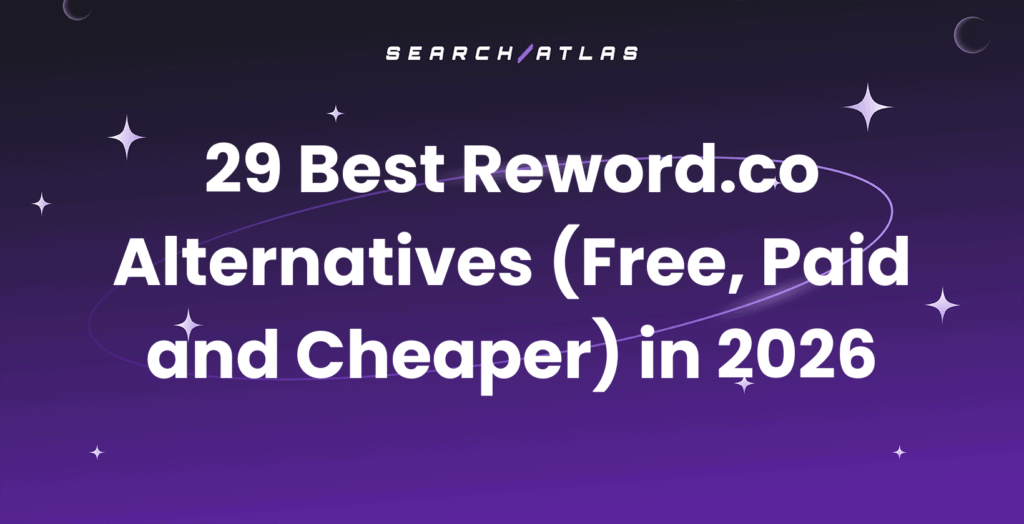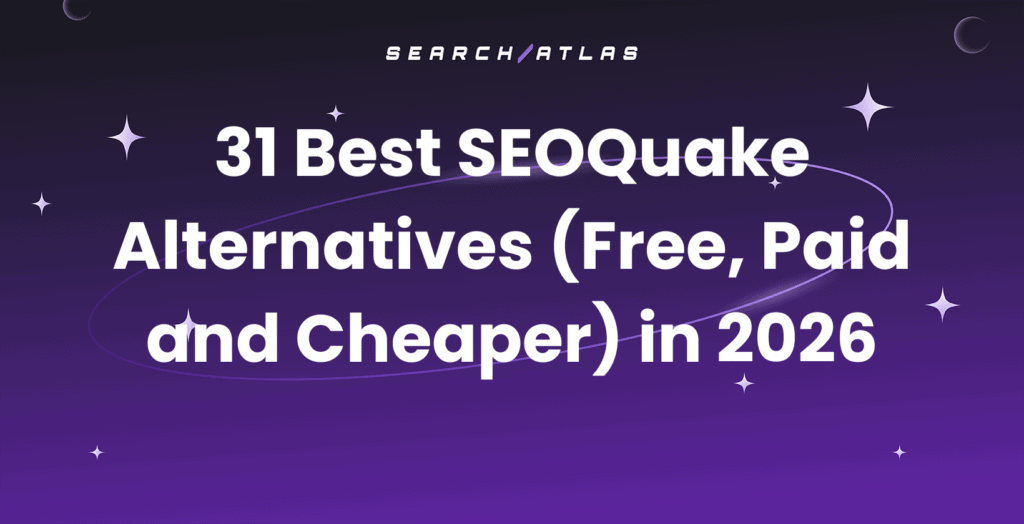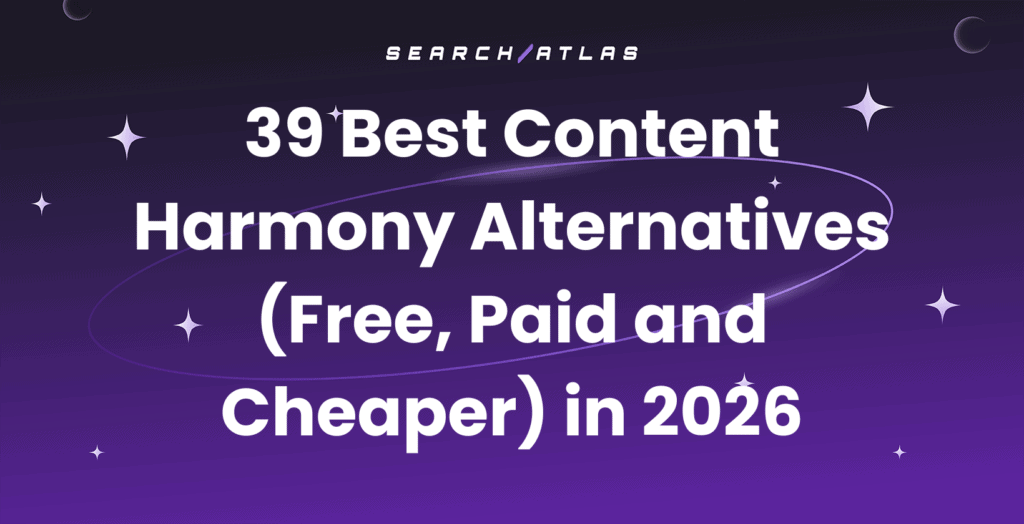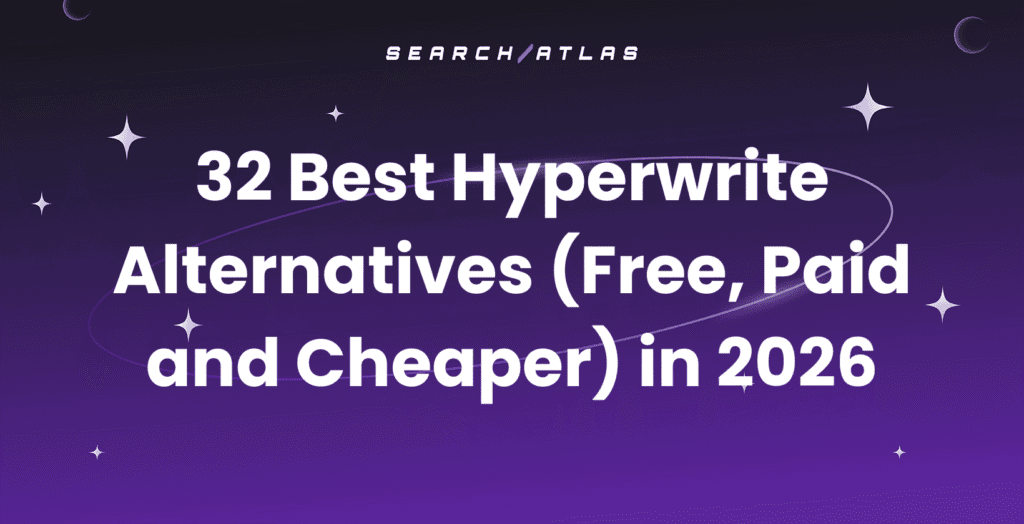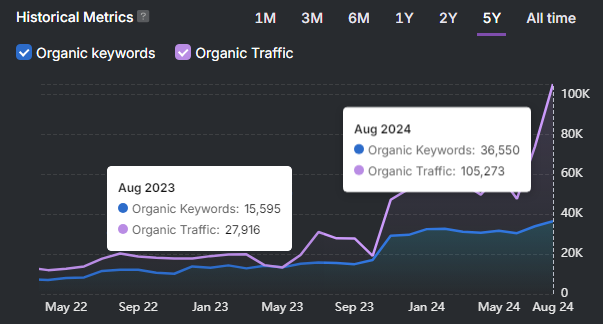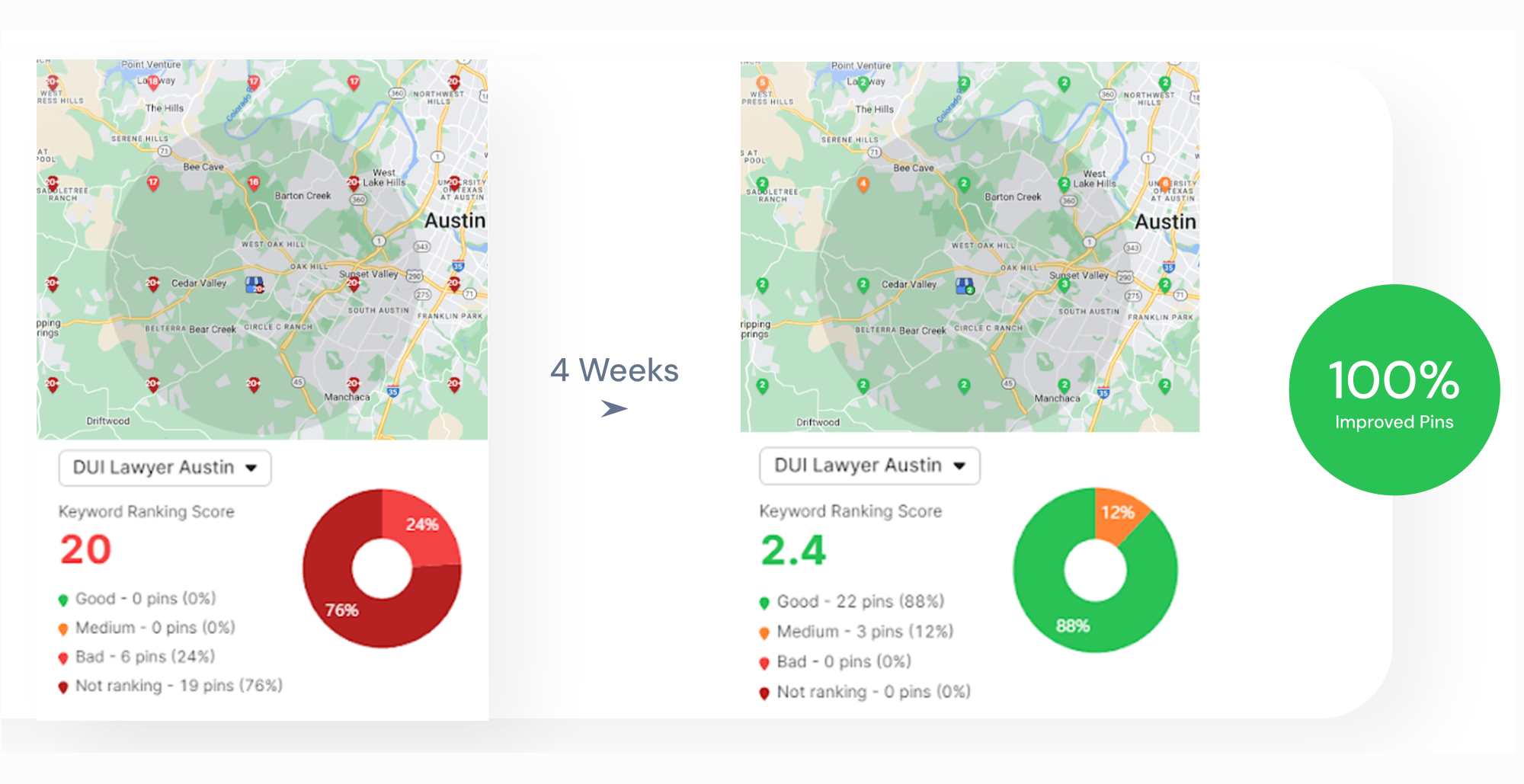Google News SEO refers to the process of optimizing news content so that it can appear in news-related search surfaces. Google News SEO emphasizes recency, topic authority, and journalistic transparency based on Google’s news ranking systems. The goal for news publishers is to rank prominently and consistently in real-time news queries.
Well-optimized news content can appear in Google News or Google Top Stories shortly after publishing, which often results in spikes in impressions and referral traffic. To be eligible, publishers must follow technical and editorial best practices, such as implementing structured metadata, optimizing mobile speed, and publishing transparent, clearly attributed content. Two of the best practices include submitting a news-specific XML sitemap and writing descriptive headlines with query matching.
What is Google News SEO?
Google News SEO is the specialized practice of optimizing news content to rank in Google News, Google Top Stories, and other news-specific search features. SEO for Google News involves technical configuration, headline formatting, and adherence to content and publisher guidelines that influence visibility across these features.
Google News or Google Top Stories SEO prioritizes article relevance to time-sensitive search demand and event-based queries. Search engines reward original reporting, factual accuracy, and proper journalistic standards while penalizing low-quality, outdated, or misleading content. Google’s news algorithm uses specialized ranking factors that differ from traditional search, with a bigger emphasis on recency, authority signals, and news-specific technical elements.
Google News SEO requires a consistent publishing cadence, transparent authorship, proper site structure, and adherence to Google’s content policies. Publishers must pay special attention to site speed, mobile optimization, and the use of news-specific schema like NewsArticle while maintaining journalistic integrity and reader experience. Success here depends on balancing timely reporting with thoughtful optimization that signals content quality to Google’s news-specific crawlers.
What is Google News Optimization in Overall SEO?
Google News optimization is a specialized subset of general SEO strategy, focused on getting news articles indexed, ranked, and surfaced in Google News app listings, Top Stories carousels, and Discover feed appearances. While traditional SEO targets evergreen rankings, SEO for news sites is built around recency, structured publishing, and topic authority within short time windows.
In the context of overall Google SEO, news optimization requires additional layers like eligibility in Google Publisher Center, compliance with content policies, and technical formatting that supports fast indexing. Google SEO systems evaluate signals like site authority, article freshness, and metadata clarity to determine which articles qualify for inclusion in news-specific results.
SEO Google News systems help publishers reach audiences during peak search interest, especially when covering developing events, announcements, or timely topics.
What is the Importance of SEO for Google News Publishers?
SEO for Google News publishers provides the much-needed visibility in highly competitive digital news. Google News drives substantial referral traffic, often accounting for 20-35% of total traffic for many news sites. The high-quality traffic typically demonstrates better engagement metrics than social media referrals, with readers consuming more content per session and returning more frequently.
Google News visibility significantly impacts publisher credibility and branding. Appearance in Google News and Top Stories positions publications as authoritative sources, strengthening audience trust. The featured placement in Google’s news ecosystem enhances brand recognition and reinforces the publisher’s status as a trusted information source. For emerging publishers, consistent Google News visibility accelerates audience building and industry recognition.
Google News optimization creates monetization opportunities that support sustainable journalism. The increased traffic from news-specific features directly impacts ad revenue potential through improved impression volume. Publishers in Google News demonstrate higher viewability rates for advertisements, increasing CPM (cost per mille) rates compared to other traffic sources. For subscription-based models, Google News readers convert to paid subscribers at higher rates than general search traffic, making news optimization a critical component of revenue strategy.
How Does Google Rank News Content?
Google ranks news content using a separate algorithm from standard web search. The Google News algorithm’s goal is to deliver original journalism, relevant updates, and diverse viewpoints based on the user’s preferences, location, and language. Ranking is fully algorithmic. Payment, ads, or commercial partnerships do not influence visibility within Google News.
The Google News algorithm evaluates the quality of the content and how well it matches the context of each user’s browsing behavior and preferences. For personalized sections like “For You” or “Picks for You,” Google News uses signals based on the reader’s past activity, interests, and followed topics.
The Google News ranking factors are listed below.
- Relevance of content. How well the article matches the reader’s query, interests, or current news trends.
- Prominence. Coverage of significant events or topics that are broadly recognized as important.
- Authoritativeness. Signals of trust, such as bylines, publisher reputation, and citations from other sources.
- Freshness. How recently the article was published, and how often the story has been updated.
- Usability. Page experience, mobile responsiveness, readability, and structured formatting.
- Location and language. How closely the article matches the reader’s region and preferred language settings.
The ranking factors of Google determine how news is ranked across surfaces such as the Google News homepage, local briefings, and topic-specific feeds.
Personalization is based on user-defined preferences or inferred interests from previous activity across Google services and YouTube, depending on individual account settings.
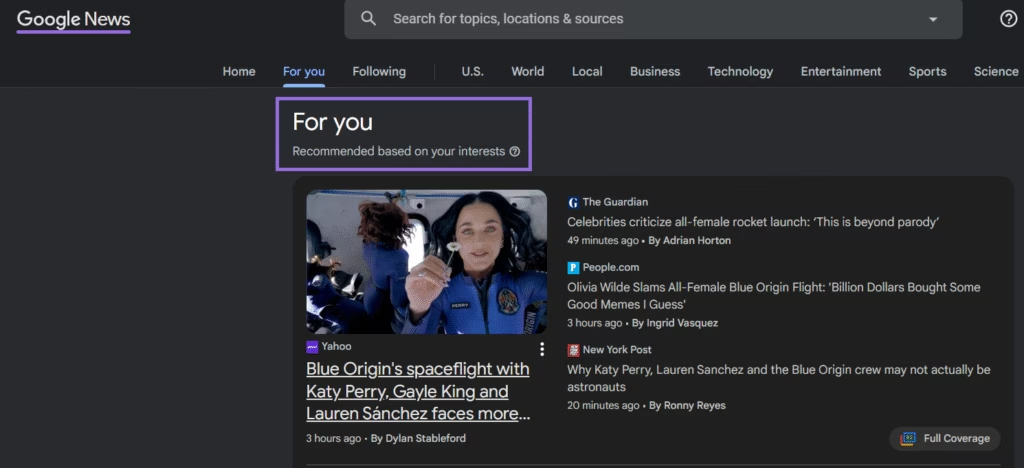
Where Do Google News Stories Appear?
Google News stories appear across multiple surfaces in both dedicated news feeds and standard search results. Understanding where your content can show up helps guide your Google Top Stories SEO efforts and determine which formats and ranking signals matter most.

The 6 primary Google News placements are listed below.
- Google News Homepage. Stories appear in curated sections like “World,” “Local,” and personalized categories. Placement is based on newsworthiness, user behavior, and content relevance.
- Google Top Stories Carousel (Search). Featured at the top of traditional search results for trending topics and breaking news queries. Appears prominently on mobile and desktop for high-volume keywords.
- Google Discover Feed. Surfaces personalized news and evergreen content based on the user’s past search activity, site visits, and topic interests. Often includes news articles, editorial features, and multimedia.
- Google News App (Android & iOS). A standalone mobile app that aggregates global and local news content. Sections include “For You,” topic-specific feeds, and publisher-based groupings.
- News Tab in Google Search:. A dedicated vertical showing only news content, usually triggered by informational or journalistic queries. Stories here are filtered differently from a general web search.
- Google Assistant and Voice Search Devices- News stories can be delivered through voice results, especially in response to “What’s the latest?” or local news queries on smart speakers and displays.
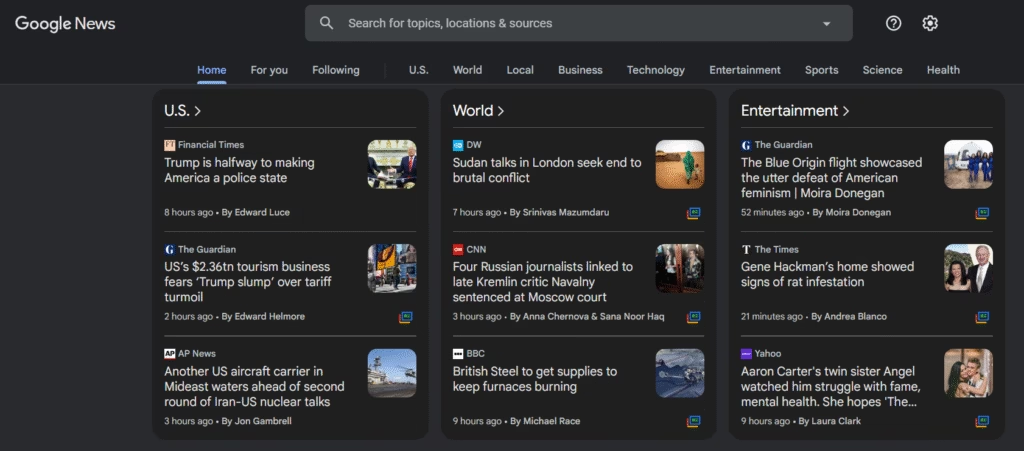
What Are the SEO Best Practices for Publishers to Appear in Google News?
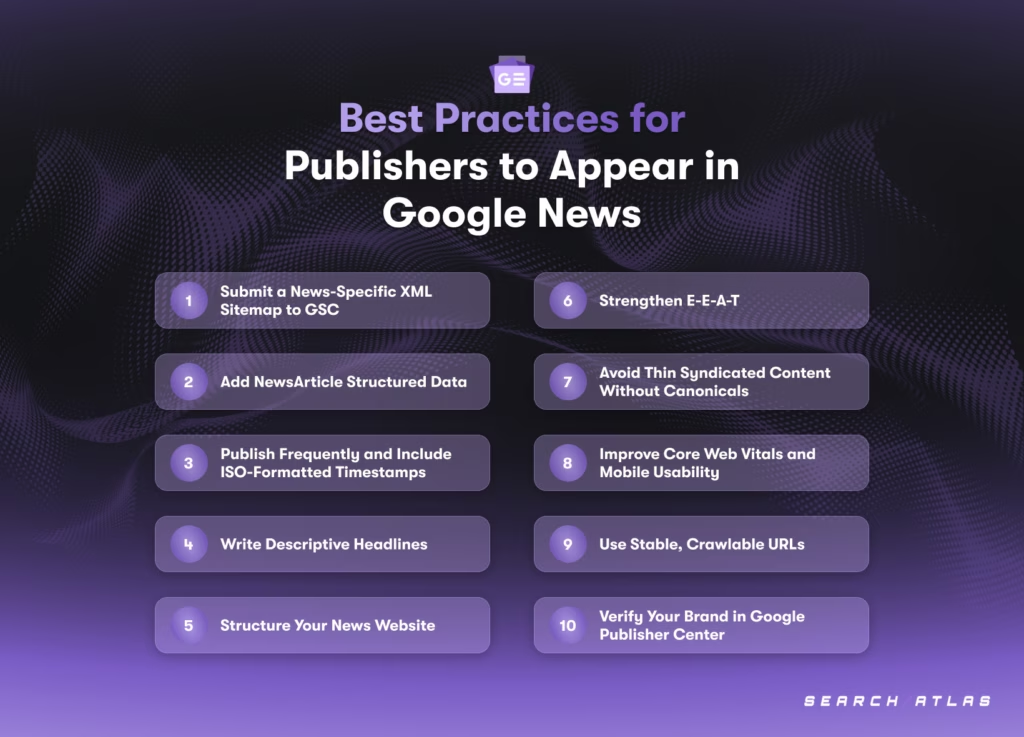
To appear in Google News, publishers must optimize content quality, technical signals, and editorial transparency. The best Google news SEO practices help news sites meet Google’s quality standards while signaling relevance and authority to the news-specific algorithms.
The SEO best practices for publishers to appear in Google News are listed below.
1. Submit a News-Specific XML Sitemap to Google Search Console
Submitting a Google News XML Sitemap improves the discoverability of news articles by Googlebot.
A news sitemap must include only articles published in the last 48 hours. Each sitemap must contain fewer than 1,000 article URLs. The sitemap should be updated frequently and include <news:news> tags such as <news:publication>, <news:publication_date>, and <news:title>.
News XML sitemaps allow Google to understand which articles are eligible for Google News and Top Stories indexing. Googlebot treats news sitemaps differently than general sitemaps because of their time-sensitive crawl logic.
The Google News sitemap should be submitted directly through Google Search Console under the Sitemaps section. Google Search Console provides validation feedback and indexing statistics specific to news content. Google Search Console will highlight any errors in the sitemap format that could be preventing proper indexation.
The Search Atlas Site Explorer Tool can help you further identify sitemap submission issues and indexation gaps. The Search Atlas Site Explorer Tool monitors real-time indexation status of news content and alerts publishers to crawl errors that might affect Google News visibility.
2. Add NewsArticle Structured Data to All News Content
Adding NewsArticle structured data to all news content provides explicit signals to Google about article attributes, publication details, and content types.
The correct implementation of the NewsArticle schema needs several mandatory News SEO properties. News SEO properties include headline, author information, publication date, modification date, featured image URL, publisher details, and accessibility status for paywalled content. Each of these properties contributes to Google’s understanding of the content’s context, recency, and authority.
For proper NewsArticle schema implementation, include the properties below.
{
"@context": "https://schema.org",
"@type": "NewsArticle",
"headline": "Complete Article Headline",
"author": {
"@type": "Person",
"name": "Author Name"
},
"datePublished": "2025-04-15T13:00:00+00:00",
"dateModified": "2025-04-15T14:30:00+00:00",
"image": {
"@type": "ImageObject",
"url": "https://example.com/images/news-image.avif"
},
"publisher": {
"@type": "Organization",
"name": "Publication Name",
"logo": {
"@type": "ImageObject",
"url": "https://example.com/images/logo.avif"
}
},
"isAccessibleForFree": "True"
}Structured data helps Google extract accurate metadata and assign articles to the correct Google News clusters. If schema markup is invalid or incomplete, Google may exclude articles from visibility.
You can generate a valid schema with the Search Atlas Schema Markup Generator, which is our Schema.org structured data generator to create JSON-LD markups.
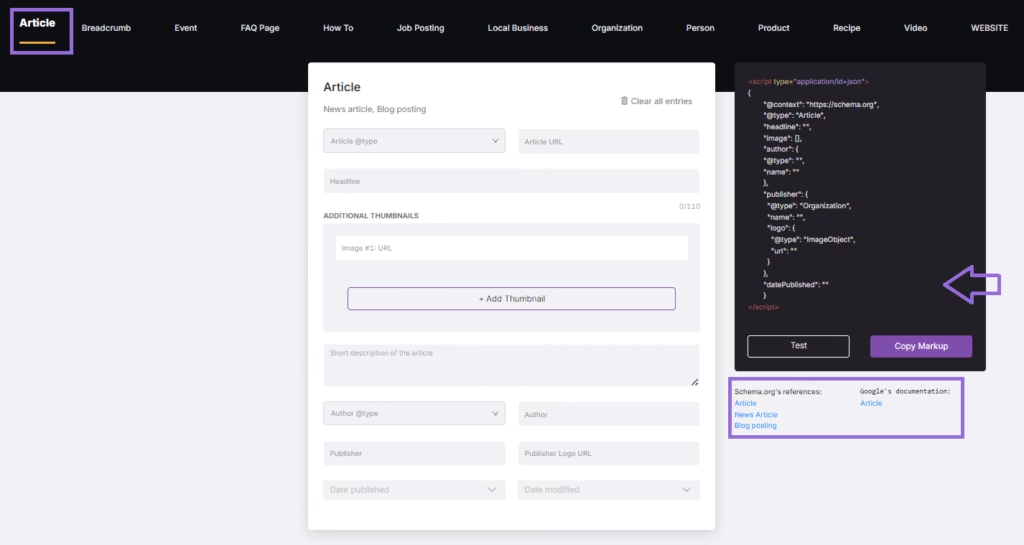
The Search Atlas Schema Markup Generator provides template-based schema creation specifically designed for news publishers. After using the Search Atlas Schema Markup Generator Tool, validate the schema through Google’s Rich Results Test.
3. Publish Frequently and Include ISO-Formatted Timestamps
Publication frequently establishes patterns of editorial activity that signal to Google your site’s status as an active news source. Google News algorithms evaluate publication consistency as one indicator of news authority. Sites with irregular publishing schedules experience decreased visibility compared to sites maintaining predictable content cadences.
Each article must include datePublished and dateModified values in ISO 8601 format. ISO-formatted timestamps must be visible on the page and present in structured data.
Google’s news crawlers evaluate the recency of content based on ISO-formatted timestamps. Articles with current timestamps receive priority in time-sensitive news surfaces.
The update frequency of timestamps influences how Google interprets content freshness. News publishers should update timestamps only when substantial content changes occur, not for minor edits.
4. Write Descriptive Headlines with Query Matching
Writing descriptive headlines with query matching serves multiple functions in Google News SEO. Article headlines communicate the primary topic, establish relevance to trending queries, and influence click-through rates from news surfaces. The headline structure directly affects how Google clusters related news stories together across publications.
Effective news headlines contain exact match keywords placed toward the beginning of the title. The position of keywords in headlines affects both algorithmic relevance and user engagement metrics. Headlines should remain under 110 characters to prevent truncation in mobile displays, preserving complete topic communication.
Compare these news SEO headlines below.
- An effective headline would be “U.S. Senate Approves $118 Billion Border and Foreign Aid Package in Bipartisan Deal”.
- An ineffective headline would be “You Won’t Believe What Just Happened in Washington”.
The effective news article headline communicates the specific news event, includes entity names, provides numerical context, and establishes the complete story at a glance.
The ineffective news article headline lacks specificity, relies on curiosity gaps, and fails to communicate the actual news topic.
Google Trends provides real-time data on rising and declining search interests by region, category, and timeframe. This helps publishers align their titles and article angles with public attention. You can use Google Trends to identify which topics are gaining momentum and craft headlines accordingly.
5. Structure Your News Website Using Section Pages and Internal Links
Structuring your news website using section pages and internal links creates a clear and hierarchical site architecture. The site architecture for news websites affects content discovery, topical association, and crawl efficiency.
A hierarchical structure with clearly defined section pages helps Google understand content categorization and editorial focus areas. This structure creates contextual relevance that improves positioning for topic-specific queries.

Each major news category should have a dedicated section URL that serves as a hub for related content. News sections typically include paths like /world/, /business/, /technology/, and /politics/. The section organization should reflect your publication’s primary coverage areas and editorial strengths.
New articles must appear on relevant section pages through automated inclusion systems. Automated inclusion ensures that every news item has multiple discovery paths throughout the site. Articles isolated from section pages or accessible only through search functionality may experience reduced news visibility. Avoid infinite scroll or client-side-only navigation frameworks.
Internal linking between topically related articles reinforces contextual associations. These contextual connections help Google understand story development and topical expertise areas. The link structure should prioritize recent content while maintaining connections to definitive coverage of ongoing stories.
The Search Atlas OTTO SEO Tool uses AI power to evaluate internal link patterns and ensure proper content discoverability through both section pages and article-to-article connections. The Search Atlas OTTO SEO Tool suggests internal linking opportunities that you can automatically deploy with a single click.
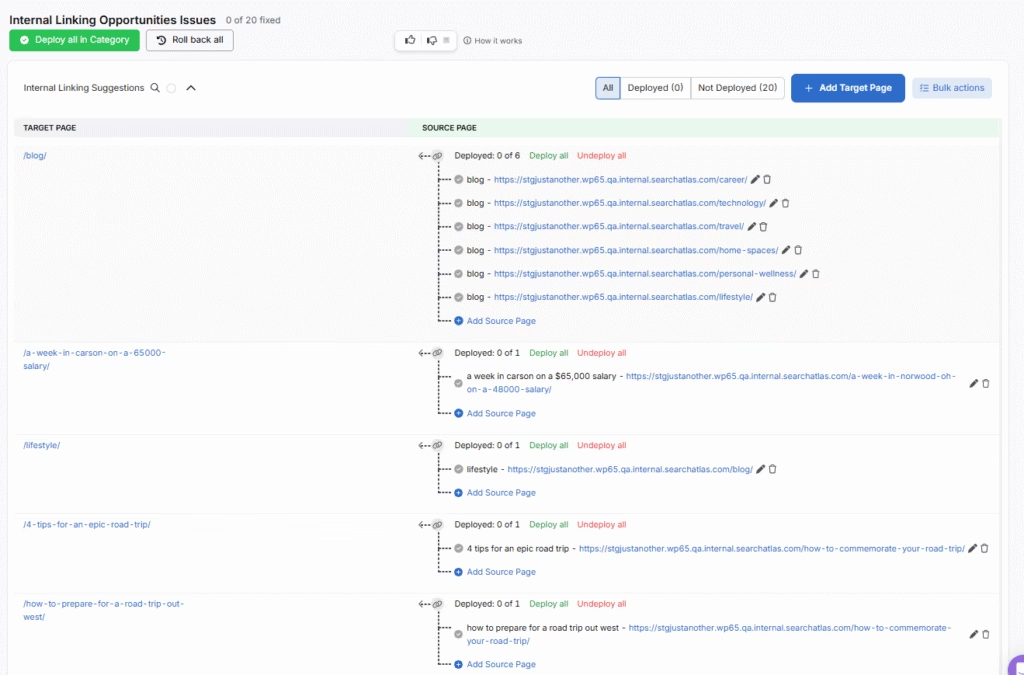
Publishers can use these insights to implement strategic linking improvements that support Google News visibility.
6. Strengthen E-E-A-T Through Author Pages and Editorial Policies
Strengthening E-E-A-T (Experience, Expertise, Authoritativeness, and Trustworthiness) signals is very important for Google News rankings. Google’s news algorithms evaluate EEAT quality signals when determining which sources receive prominent positioning. The E-E-A-T implementation for news publishers requires both article-level and site-level optimizations.
Every news article should include a bylined author with a clickable link to a dedicated author page. The author page establishes the journalist’s credentials through biographical information, topic expertise, and content history.
Author pages should include the elements outlined below.
- Professional biography highlighting relevant experience.
- Credentials, education, or specialization areas.
- Chronological archive of previously published articles.
- Optional professional social media profiles or contact information.
Beyond individual author signals, publications must establish site-wide trust indicators. Site-wide trust indicators include accessible editorial standards pages, transparent correction policies, and clear differentiation between news and opinion content. The About section should detail fact-checking processes and ethical guidelines followed by the publication.
7. Avoid Thin Syndicated Content Without Canonicals
Thin syndicated content without canonicals refers to news or informational content republished from another source but without proper attribution, originality, or technical signals (like canonical tags) that tell Google it’s not the original version. Google penalizes publishers that republish syndicated or duplicate content without proper attribution or added value.
Content originality influences Google News ranking priority. Google’s news algorithms favor publishers providing original reporting, as this preference aligns with Google’s quality guidelines that emphasize unique value and differentiation.
When using syndicated content, publishers need to use <link rel=”canonical”> pointing to the original publisher. Canonical tags ensure appropriate attribution while avoiding potential duplicate content issues.
To improve the ranking potential of syndicated material, news publishers need to enhance the content with exclusive elements, such as the elements listed below.
- Additional reporting with exclusive quotes.
- Local context or regional impact analysis.
- Supporting data visualization or multimedia elements.
- Expert commentary that adds perspective to the original reporting.
Relying heavily on unenhanced press releases or wire service content without differentiation typically results in lower Google News SEO visibility. The Google News algorithms identify patterns of republishing behavior and reduce prominence for publications that routinely publish unmodified syndicated content.
8. Improve Core Web Vitals and Mobile Usability
Core Web Vitals performance metrics and mobile usability directly influence Google News rankings. News traffic primarily comes from mobile devices. Google evaluates speed, interactivity, and visual stability when determining news placement.
For optimal Google News performance, publishers should aim for the Core Web Vitals benchmarks listed below.
- Largest Contentful Paint (LCP) under 2.5 seconds.
- Interaction to Next Paint (INP) under 200 milliseconds.
- Cumulative Layout Shift (CLS) under 0.1 score.
News layouts must adapt to different screen sizes without requiring horizontal scrolling or pinch-to-zoom interactions. Touch targets for links and buttons should be properly sized and spaced for mobile users.
Image SEO plays a critical role in news performance. Publishers should serve images in modern formats like WebP or AVIF with proper sizing and compression. Implementing lazy loading for below-the-fold images helps prioritize content delivery while preserving bandwidth.
The Page Explorer section within the Search Atlas Site Audit Tool identifies Core Web Vitals issues, as well as issues related to Images, Page Headers, Content, and other elements that affect your news page’s health.
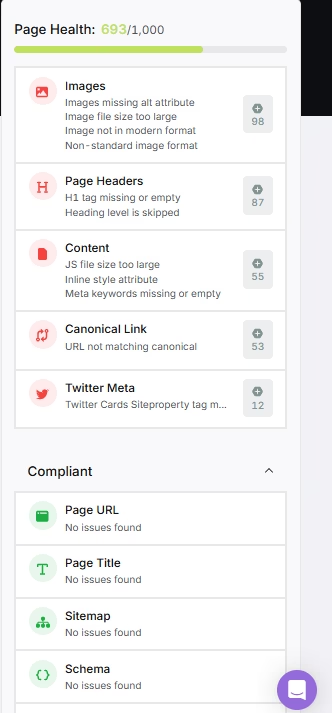
Publishers can use the insights from the Search Atlas Site Audit Tool to improve performance scores and enhance user experience signals for Google News consideration.
9. Use Stable, Crawlable URLs
Each news article must have a stable, crawlable URL with proper canonicals that remains consistent throughout the content’s lifecycle.
The tips to achieve unique, stable, crawlable URLs are listed below.
- Avoid parameters like ?id=1234 or session tokens.
- Do not use fragment identifiers (#) for content segmentation.
- Keep slugs readable and include key terms (e.g., /us-economy-jobs-report-april-2025/).
- Use <link rel=”canonical”> to resolve duplicate URLs created by tagging or pagination.
Changing URLs after publishing may result in deindexation.
10. Verify Your Brand in Google Publisher Center
Verifying your brand in Google Publisher Center provides official recognition of your publication within Google’s news ecosystem. The Publisher Center connection establishes brand identity signals that help Google properly attribute and display your content across news surfaces.
While this is not mandatory for Google News inclusion, verification improves brand presentation and content categorization.
The Publisher Center registration process requires several main components listed below.
- Publication title and description.
- Logo and brand color scheme.
- Primary language and region of publication.
- Google Search Console property verification.
Connecting Search Console with Publisher Center creates an integrated verification system. This connection guarantees consistency between technical implementation and editorial presentation.
How to Submit Content to Google News?
Submitting news content to Google News involves a sequence of technical and editorial actions that help Google discover, parse, and validate your publication.
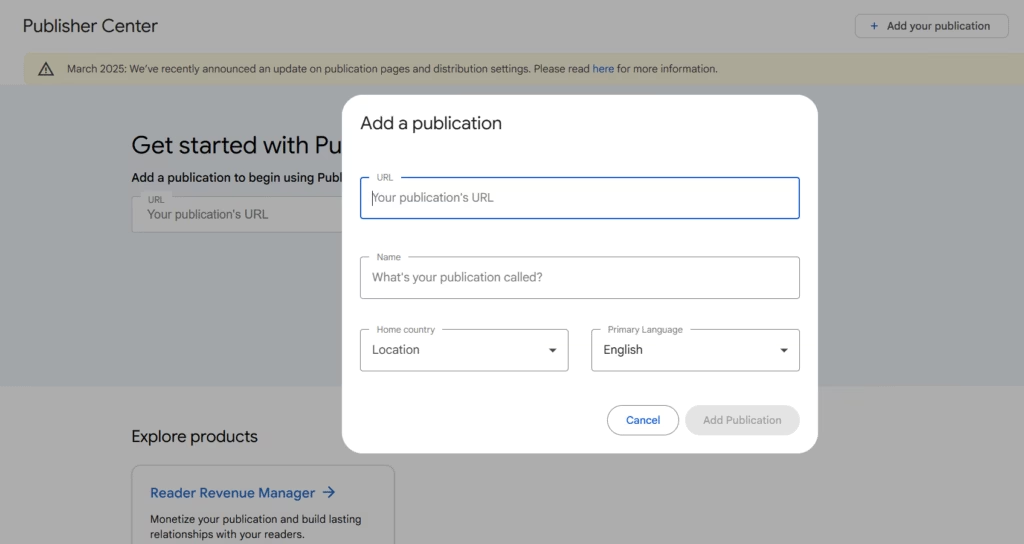
The steps for submitting news articles to Google News are listed below.
- Create and verify a Google Publisher Center profile at publishercenter.google.com using your Google account.
- Provide publication details including your publication name, primary language, geographic focus, and contact information. Complete all optional fields like social media accounts and logos to enhance your profile completeness.
- Define content sections that reflect your publication’s coverage areas, such as Politics, Business, or Technology. These sections help Google categorize your content appropriately.
- Set up content distribution preferences regarding inclusion in various Google News products like the News app, Discover feed, and News on Search.
- Implement proper technical configuration, including structured data, news sitemaps, and clear site architecture as detailed. These elements support successful content discovery and classification.
- Submit your application for review once all elements are properly configured. Google’s team evaluates submissions against news content policies and technical requirements, which may take several weeks.
- Monitor your approval status in the Publisher Center dashboard. If rejected, Google typically provides feedback about specific issues to address before resubmission.
After successful approval, maintain consistent publishing practices that align with Google’s news content policies. Regular updates, adherence to journalistic standards, and technical optimization support ongoing visibility in Google News properties.
How Do You Get Google News Approval?
Getting Google News approval is optional but valuable for branding and section control. Inclusion in Google News is based on crawlability, newsworthiness, and site trust.
First, you must ensure that your content aligns with Google News content policies, which cover transparency, original reporting, fact-checking, and deceptive practices. Content must be written by identifiable authors and avoid clickbait, auto-generated text, or promotional masquerading as news.
Secondly, your site must offer technical quality, like fast page speeds, mobile usability, and valid structured data using NewsArticle schema, and be accessible to GoogleBot and other crawlers.
Third, create a publication profile in Google Publisher Center, verify your site, and configure content sections. While this does not guarantee placement, it gives Google better signals to associate your brand with consistent news output.
Finally, publish regularly. Google prefers frequent and original publication activity from trusted domains. Manual inclusion increases the chances of your logo appearing in Google News apps and surfaces, improving trust and click-through rates.
How to Perform a Google News SEO Audit?
A Google News SEO audit is the process of reviewing the technical, structural, and content-related elements that influence how news articles are discovered, crawled, indexed, and ranked by Google.
The general steps to perform a Google News SEO audit are listed below.
- Verify Google News inclusion status by checking Publisher Center approval and confirming appearance in news-specific search features. Review any manual actions or policy violations that might affect visibility.
- Evaluate technical news configurations, including structured data implementation, XML news sitemaps, and mobile optimization. Test page speed specifically on mobile devices, as Google News prioritizes performance more strictly than general search.
- Analyze content quality signals against Google’s news-specific guidelines. Review authorship attribution, transparency policies, and E-E-A-T signals across a representative content sample.
- Examine news-specific metadata, including headline formatting, “news_keywords” meta tag implementation, and OpenGraph properties for news content sharing.
- Assess competitive positioning by comparing visibility in news features for primary competitors. Identify content types, topics, and formatting approaches that consistently earn news visibility for similar publications.
- Review analytics data for news-specific traffic patterns, including referral sources, user engagement metrics, and temporal trends related to publishing schedules.
- Compile findings into a prioritized action plan based on the Google SEO report for impact potential and implementation complexity. Focus on critical issues affecting news visibility before addressing secondary optimization opportunities.
Quarterly Google news SEO audits provide sufficient frequency to identify emerging issues while allowing time to implement and measure improvements between reviews.
What are the Best Google News SEO Tools?
The best Google News SEO tools provide specialized features for monitoring, analyzing, and optimizing news-specific content. Google News SEO tools address the unique requirements of news publishers pursuing visibility in Google News features.
The most effective Google News SEO tools include Google’s official resources and specialized third-party platforms like the Search Atlas SEO Platform. Google’s tools provide direct insights into news performance and indexing, while third-party solutions offer expanded features for competitive analysis and optimization. The best Google News SEO tools are listed below.
Google Search Console serves as the foundation for news performance analysis. The Performance report with news filter options shows impressions, clicks, and positions specifically in news features. The URL Inspection tool verifies proper indexing and rendering of news pages. Coverage reports identify crawling or indexing issues affecting news content discovery.
Google Publisher Center provides the official channel for managing Google News presence. The Analytics section shows news-specific performance metrics across Google properties. Direct feedback channels offer policy compliance information affecting news visibility.
Google PageSpeed Insights (PSI) measures critical performance metrics affecting news rankings. Core Web Vitals analysis identifies specific issues impacting news visibility, particularly on mobile devices. Optimization recommendations address news-specific performance requirements that exceed general SEO standards.
Search Atlas SEO Platform serves as an all-around Google News optimization solution. The Search Atlas SEO platform enhances news visibility through AI-powered headline analysis, structured data validation, technical fixes, and news-specific content optimization. The platform’s competitive analysis tools benchmark news performance against similar publications.
By combining these powerful tools, news publishers can implement complete optimization strategies tailored to Google News requirements. The free Google tools provide data directly from the search engine, while the Search Atlas SEO Tools deliver the advanced analysis and implementation capabilities needed for competitive advantage in the news world.
Does Google Pay for News Content?
Yes, Google pays for news content, but only in specific cases. Google doesn’t pay publishers just for showing up in Google News or Top Stories. Articles appear in those spots based on how well they meet Google’s ranking systems
That said, Google does compensate some publishers through programs like Google News Showcase and Reader Revenue Manager (RRM). These are part of the Google News Initiative and involve licensing deals or tools that help publishers earn money directly from readers.
News Showcase pays select publishers to provide curated news panels and in-depth content across Google platforms. Reader Revenue Manager helps publishers set up subscriptions or memberships and keep most of the earnings.
So while most news content isn’t paid for directly, Google does support monetization through partnerships and tools for eligible publishers. Getting paid depends on your participation in these programs, not just being listed in Google News.
Is It Hard to Get on Google News?
Yes, it can be hard to get on Google News, especially without the right structure and signals. Google looks at how your site is built, how trustworthy your content is, and how consistently you publish.
Just being indexed by Google doesn’t mean you’ll show up in News. Getting into Top Stories, the News tab, or the Google News app requires real editorial effort and technical hygiene.
That said, if you’re covering a niche or local beat well and have the site set up to back it up, getting on Google News is absolutely doable.
How to Master Google News Optimization?
Mastering Google News optimization means exceeding basic SEO and learning how to meet the specific requirements of Google’s news-serving systems. It starts with building a technically sound website using clean URLs, fast mobile performance, and valid NewsArticle structured data.
From there, focus on producing timely, original content with clear headlines that match trending search queries. Publishing frequently and transparently with bylined authors, editorial guidelines, and E-E-A-T signals builds trust and authority over time.
To truly master Google News optimization, monitor performance using Google Search Console’s News tab, analyze crawl behavior and indexation rates, and refine your headlines and internal links based on what drives impressions in Top Stories and Discover.
Staying up to date with Google’s content policies, news ranking updates, and programs like Publisher Center and News Showcase helps you keep your visibility strong in the long run.
What Are the Latest Google SEO News and Updates for News Publishers?
The latest Google SEO news and updates for news publishers are outlined below.
- March 2025 Core Update Emphasis on Content Quality and E-E-A-T. Google completed its March 2025 Core Update, which has led to notable shifts in search rankings. This update places a stronger emphasis on content quality, originality, and the principles of Experience, Expertise, Authoritativeness, and Trustworthiness (E-E-A-T). Publishers relying heavily on AI-generated or low-value content have observed declines in visibility.
- Transition to Automatically Generated Publication Pages in Google News. Google News has fully transitioned to automatically generated publication pages and discontinued the use of manually submitted RSS feeds or web locations via Publisher Center. This change aims to streamline the publisher workflow and simplify the product experience. As a result, customization features for publication pages in Google News have been removed.
- Crackdown on “Parasite SEO” and Site Reputation Abuse. Google is intensifying its efforts against “parasite SEO,” targeting content that exploits a website’s ranking authority to display irrelevant or low-quality material. It includes articles produced by third-party services that may not align with the host site’s primary focus. Publishers are now held accountable for all content on their sites, regardless of authorship, leading to stricter content policies and enforcement.
- Impact on Freelance Contributions and Content Strategies. In response to Google’s updated policies, several media outlets, including Forbes and Dotdash Meredith, are reevaluating their use of freelance writers. These organizations are reducing reliance on external contributors to mitigate risks associated with content deemed as “site reputation abuse.” Google News has refreshed with this latest news shift, which underscores the importance of maintaining high editorial standards and oversight.
What is the Relation Between Google News SEO and SEO Content?
Google News SEO is a real-time extension of SEO content strategy. While traditional SEO content aims to build authority over time by covering search topics in-depth, Google News SEO works on shorter timelines, ranking articles based on freshness, relevance to breaking trends, and structured formatting.
What connects Google News SEO and SEO Content is entity coverage. If a publisher already ranks for evergreen SEO content around a topic, their news articles on that same topic are more likely to rank in Top Stories or News surfaces. In other words, the strength of your topical authority from SEO content feeds into your visibility in Google News. But the formatting, timing, and publishing frequency requirements differ.
What is the Relation Between Google News SEO and Technical SEO?
In Google News SEO, technical SEO determines whether your news content can even be seen by Google’s news systems. Without a crawlable site, valid schema, and fast load times, your articles won’t make it into News indexes, no matter how good the content is.
But the main difference is that Google News SEO pushes technical SEO further, requiring ISO timestamps, a dedicated news sitemap, and stricter crawl latency handling. Unlike standard technical SEO practices, where Google may revisit pages weekly, news crawlers operate on minute-to-hour intervals. That means even small technical issues (like slow server response or broken structured data) can block visibility in near-real time.
What is the Difference Between Google News SEO and Google Discover SEO?
Google News SEO and Google Discover SEO are two distinct branches of search visibility, each driven by different algorithms, intent signals, and user behavior patterns.
Google News SEO focuses on timely, event-based coverage. Google News SEO is built for surfacing articles about breaking news, politics, global events, or trending topics in real time. Articles optimized for Google News typically appear in the Top Stories carousel, the News tab, and the Google News app. Success here depends on publishing frequency, recency, clear headlines, and structured data like NewsArticle schema.
Google Discover SEO, on the other hand, is a personalized content feed served through the Google app or Chrome’s mobile homepage. Google Discover SEO favors evergreen or feature-style content that matches users’ interests, behavior history, and engagement patterns, not necessarily what’s trending globally. Google Discover traffic spikes often come from visually rich, scrollable content like editorial pieces, listicles, or analysis with high click potential.


